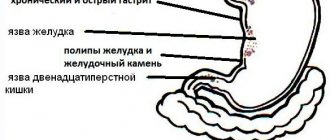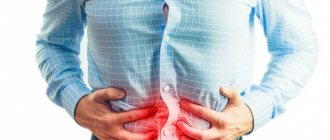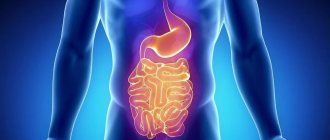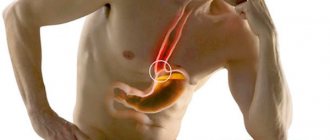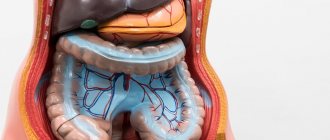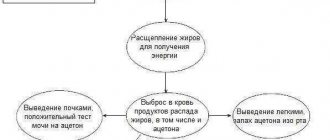Does your stomach hurt under your ribs? Pain in the upper abdomen under the ribs is a common symptom, especially characteristic of the following pathologies:
- Gastritis;
- Stomach and duodenal ulcers;
- Pancreatitis;
- Cholecystitis.
Cuts under the ribs on the right side are also characteristic of liver diseases. Lung pathology is indicated by subcostal pneumalgia, occurring on the right, left, in the middle, and aggravated by coughing. The same floating pain under the ribs is also characteristic of vegetative-vascular dystonia. This article will discuss pain in the upper abdomen that is related to dysfunction of the digestive system.
Gastralgia
Inflammation of the stomach
Dull, or, on the contrary, sharp pain in the anterior hypochondrium of the abdominal cavity causes inflammation of the stomach with high or normal acidity. This pathology is characterized by the occurrence of painful sensations in a state of hunger, due to the fact that gastric juice irritates the inflamed gastric mucosa.
But eating does not alleviate the condition, but on the contrary, it can increase the pain, because after eating, the inflamed mucous membrane is irritated by the food taken, especially if it is hard and high in acids. Therefore, patients with gastritis are recommended to eat starch-containing soups, jelly and other dishes that envelop the walls of the stomach.
Gastritis with high acidity is also characterized by symptoms such as heartburn, unstable stools prone to constipation. Aching pain and a feeling of heaviness under the solar plexus indicate the presence of gastritis with low acidity. This condition is especially worse after eating.
One of the signs confirming this diagnosis may be belching something bitter, sour, or something eaten. Vomiting with this form of gastritis brings relief. Malabsorption leads to decreased body weight, increased sweating of the hands and feet, chronic anemia, and vitamin B12 deficiency.
Stomach diseases causing abdominal pain
If there is aching or bursting pain in the abdomen, then inflammation of the gastric mucosa is likely. Girdle pain in the upper abdomen occurs with the development of pancreatitis. Additional symptoms are bitterness in the mouth, fever, and indigestion.
Pain localized in the upper abdomen and shifted to the left may appear with pathologies of the intestines or pancreas, and pain spreading to the right is possible with inflammation of the gallbladder. Let's consider the most common pathologies of the stomach that cause pain in the area of the xiphoid process.
Inflammation of the gastric mucosa can be caused by several factors. In 95% of cases, examination of patients reveals a bacterium that can survive in an acidic environment. During its life, it releases toxins that negatively affect the gastric mucosa, which leads to inflammation.
Often people are asymptomatic carriers of this bacterium, but with poor diet, frequent stress, smoking, and taking medications, gastritis begins to develop. The mucous membrane can also become inflamed in diseases that are characterized by an increase in the acidity of gastric juice or not enough mucus is produced to protect the cells of the stomach tissue from aggressive influences.
In addition to pain in the epigastric region, bad breath occurs, nausea can occur both before and after meals, heartburn and migraine appear. If you follow the diet, the pain goes away within two days.
A hernia appears when parts of organs that should be located above the diaphragm (part of the esophagus, cardiac part of the stomach, intestinal loops) prolapse into the chest cavity. With pathology, the pain is usually in the epigastric region, spreads along the esophagus, can radiate to the shoulder blades and back, and sometimes it is encircling.
As a rule, discomfort occurs after eating, physical activity, or when coughing while lying down. The symptom intensifies when bending forward. Discomfort goes away after belching, taking a deep breath, drinking water, vomiting, or changing position. Patients also complain of heartburn, hiccups, arrhythmia, and difficulty swallowing.
Pathology occurs when the ligaments of the esophageal opening of the diaphragm are weakened; this occurs due to the fact that with age, connective tissues lose elasticity and atrophy. Increased intra-abdominal pressure, which occurs with chronic constipation, obesity, blunt abdominal trauma, heavy lifting, sudden bending, severe vomiting, hacking cough or heavy physical labor, increases the risk of hernia formation.
The disease is treated with medication. Antacids and those that reduce the secretion of hydrochloric acid are prescribed. The patient is recommended to eat small meals, diet, adjust weight, and avoid physical activity. Surgical treatment is prescribed if complications arise or if conservative treatment does not produce results.
The diameter of the esophageal lumen may decrease in the presence of a tumor or scar tissue. Symptoms of the disease include pain along the esophagus, belching, difficulty swallowing, vomiting, and bleeding. Dry, poorly chewed food cannot pass through the narrowing of the esophagus. This causes pain and vomiting.
Esophageal stenosis can develop with any disease of the digestive system, which is accompanied by vomiting, or with an infectious disease (diphtheria, scarlet fever, syphilis, tuberculosis). Treatment is by dilation of the esophagus with bougies or balloon catheters, endoscopic dissection, esophageal replacement, or esophagoplasty.
The disease develops against the background of a malfunction of the pancreas and manifests itself in impaired digestive function. There is pain in the upper abdomen, nausea, heartburn, bloating and heaviness in the stomach, and lack of appetite.
Organic dyspepsia develops with pathologies of the digestive organs; functional dyspepsia is said to exist if there are no organic lesions. The diagnosis is made only if other pathologies of the gastrointestinal tract are excluded. Treatment is symptomatic.
The diagnosis of functional dyspepsia is made only if pain in the middle of the abdomen in the upper part continues for more than one week a month, there is no organic lesion, and the pain does not go away after defecation. The pathology is believed to be caused by a mental disorder.
An ulcer is a complication of gastritis. It occurs when inflammation affects not only the mucous tissue, but also the lining of the stomach located underneath it. Pain can be felt in the epigastrium both before eating, which is caused by an increase in the level of hydrochloric acid, and after eating, since incoming food irritates the inflamed mucous membrane.
There are peptic ulcers and symptomatic ulcers. The latter arise against the background of an unfavorable factor and, after its elimination, are completely cured. Such factors include stress, drug therapy, and diseases of the endocrine glands. Peptic ulcer disease is caused by the presence of Helicobacter and has a long-term recurrent nature.
Stomach and duodenal ulcers
Gastric ulcers are characterized by sharp pain localized in the left half of the hypochondrium.
Gastric and duodenal ulcers are characterized by sharp pain, localized in the left half of the hypochondrium, starting from the middle of the abdomen. Often discomfort occurs at night. The disease worsens in the off-season, that is, in spring or autumn. The pain sometimes radiates under the left rib, into the back and lower back. To alleviate the condition, the patient is forced to take a position that allows him to press the painful part of the abdomen:
- Lie on your stomach
- Sit on your haunches with your hands on your stomach,
- They press themselves against the table.
Read: A child has a stomach ache at night: possible causes of the problem
Ulcers, like gastritis, are characterized by “pain on an empty stomach”, which appears one and a half to three hours after eating. Physical stress and nervous disorder can be a provoking factor for the occurrence of pain. Antacids help in this condition. Some patients use a heating pad and soda solution.
Sometimes the pain occurs due to bleeding from the part of the stomach affected by the ulcer, and this can be dangerous. Additional symptoms indicating the presence of stomach and duodenal ulcers are heartburn, flatulence and constipation. With a long-term illness, patients lose weight, they develop headaches, weakness, and increased irritability.
Acute, dagger pain with perforation of the stomach and duodenum
Perforation of the stomach or duodenum is characterized by acute dagger pain.
Perforation of the stomach or duodenum is characterized by acute dagger pain. This pain forces the patient to assume the fetal position - lying on his side with his legs pressed to his stomach. At first it concentrates in the epigastric region, that is, “under the stomach,” but then moves to the right, under the last rib.
This is the contents of the stomach spilling into the abdominal cavity. After an acute attack, temporary relief may occur. If the patient does not receive timely treatment, the perforation will result in peritonitis, which will cause the patient’s death. Therefore, a patient diagnosed with a stomach and duodenal ulcer needs to be more attentive to his body.
And if acute stabbing pain occurs, immediately call an ambulance. Because in this situation there is only one way out - surgical intervention. Is it possible to avoid ulcerative perforation when the ulcer damages an organ through and through? Yes, you can, if you don’t let the disease progress and treat it in a timely manner, follow diets and all doctor’s instructions, take medicinal herbal infusions and decoctions, and avoid stress and anxiety.
Stomach cancer
Pain in the stomach area, that is, in the middle under the ribs with a transition to the left, is characteristic of stomach cancer in the last stages. The initial stage of oncological pathology is always asymptomatic, and this is where the insidiousness of oncological growths lies. At an early stage the following are noted:
- weight loss,
- change in taste preferences,
- aversion to meat dishes,
- anemia,
- signs of jaundice,
- decreased performance.
Read: Uterus. Some diseases, pathologies and serosometer of the uterus
Cancer occurs with gastritis with low acidity, develops from polyps and against the background of an ulcer of the cardial part of the stomach. Therefore, patients with these diseases need to be more attentive to their body so as not to miss the formation of a malignant tumor.
Pathologies of the pancreas
Pathology of the pancreas
Sudden, unbearable, girdling pain under the ribs indicates acute pancreatitis - inflammation of the pancreas. The pain occupies the entire upper abdominal region, and responds under both shoulder blades. Quite often it is accompanied by vomiting, which can increase the pain.
The provoking factor for vomiting is the desire to eat something or drink water. Therefore, during acute attacks of pancreatitis, there is no need to offer the patient food and drink. Acute pancreatitis is also indicated by a bluish tint of the skin, pinpoint hemorrhages in the navel area, a drop in blood pressure, all this occurs due to blood poisoning by enzymes entering the bloodstream from the inflamed pancreas.
One of the causes of acute pancreatitis is drinking too much alcohol. Therefore, the number of patients with attacks of acute inflammation of the pancreas increases sharply in the post-holiday days. Doctors managed to nickname pancreatitis “New Year’s disease.”
At the first signs of pancreatitis, do not try to self-medicate. The patient must be immediately sent to the hospital.
Chronic pancreatitis
This disease is characterized by girdling pain, covering the entire upper abdominal area under the ribs, and responding under the shoulder blades. Appears after fatty foods. The pain worsens when the patient lies on his back, so during an attack of pain the patient tries to sit leaning forward. Exacerbation of the disease is characterized by impaired absorption, which leads to greasy stool and diarrhea.
As a result of digestive disorders, the body does not receive enough necessary nutrients, causing the patient to lose weight and develop general exhaustion of the body and vitamin deficiency.
Causes of pain
There are many reasons for the occurrence of painful syndrome in the upper abdomen. Determining their exact location and type of pain can help in determining the causes of pain syndromes.
Gastritis or inflammation of the gastric mucosa is one of the causes of pain in the upper abdomen. In addition, before or after eating, the following symptoms may occur:
- nausea, vomiting;
- fast saturation;
- belching;
- heartburn, a burning sensation in the throat or behind the breastbone;
- darkening of the stool;
- cramps in the upper region of the stomach;
- feverish condition.
The causes of acute gastritis can be:
The causes of chronic gastritis can be: infections (bacterium Helicobacter pylori), chronic poisoning.
Gastroparesis (slowing of the emptying process due to insufficient muscle relaxation), in addition to pain in the stomach after eating or during eating, is characterized by:
- early saturation;
- heartburn;
- bloating in the upper abdomen;
- belching.
Peptic ulcer disease is manifested by characteristic long-term pain in the center of the stomach. During or after eating, dull or burning pain occurs in the upper abdomen, which can be girdling in nature. Pain occurs due to the presence of open ulcers (wounds) in the inner layer of the stomach. If foci of inflammation are located in the first part of the small intestine, then pain can occur between meals or at night.
Such a dangerous disease as stomach cancer includes pain in the upper and middle zones of the stomach among its symptoms. In addition, other symptoms of the disease are:
- sudden weight loss;
- lack of appetite;
- change in color of stool to almost black;
- nausea.
Acute pancreatitis can cause pain in the center of the stomach or in the upper left. It may also be accompanied by nausea, loose stools, white diarrhea, and poor appetite.
There are other diseases that can cause stomach pain of varying intensity and nature.
- Painful sensations in the central upper zone of the stomach can appear as a result of varicose veins of the esophagus (more often observed in chronic alcoholics).
- All pathologies of organs that are located in the left upper abdomen (spleen, diaphragm, some parts of the intestine) can also be causes of pain: enlargement and rupture of the spleen (additional symptoms include blue discoloration of the peri-umbilical area);
- intestinal dysfunction (accompanied by constipation or diarrhea with bloody discharge, temperature may rise, nausea or vomiting);
- diaphragm hernia. In addition to pain in the upper left abdominal region, pain can occur in the chest area;
- liver pathologies. Additional symptoms may occur, such as increased sweating, nausea, yellowing of the skin and sclera of the eyes. The painful sensations themselves are felt more in the upper zone of the stomach on the right;
- pancreatic diseases. May be accompanied by high fever, vomiting, nausea, pain resistance to antibiotics;
- rachiocampsis. Due to the close location of the stomach to the vertebrae, when nerves are pinched, pain can be felt in the epigastric part on the left or right side;
- renal colic. Pain occurs when moving stones.
- eating solid foods;
Video on the topic:
- The protrusion of part of the small intestine through clefts in the upper abdominal muscles can provoke the appearance of unpleasant painful sensations of a cramping nature. In addition to pain in the upper region of the stomach, symptoms of this condition include the appearance of a small bulge that can be felt.
- A fracture of the lower part of the chest leads to pain in the upper, central parts of the stomach, and they can change their intensity while moving, walking, or bending forward; the pain can worsen or go away.
- The presence of constant dull pain in the upper abdomen, which periodically intensifies during or after eating, may indicate a weakening of the aortic wall (in patients over 50 with atherosclerosis or other diseases that contribute to protrusion of the aortic wall or splitting of its layers).
- Heart attack (this may begin with a tingling sensation in the upper abdomen when inhaling or exhaling).
- Excruciating pain in the upper abdomen can be a sign of appendicitis, but it is predominantly localized in the right side of the abdomen and does not affect its central area.
- In women, pain in the upper and central part of the abdomen of a pulling nature can be a symptom of pathologies of the reproductive system - ovarian cysts, ectopic pregnancy, miscarriage and others.
- Abdominal muscle injuries. In addition to the gnawing pain in the upper zone of the stomach, you can observe a small noticeable bulge in the form of a hematoma.
- Pancreatic dysfunction.
- Abuse of coffee and alcoholic beverages, which leads to irritation of the mucous membrane and causes pain in the form of pain in the left intercostal space.
- Smoking, stress and poor diet.
Hepatic colic and cholecystitis
Chronic cholecystitis manifests itself as moderate pain under the right rib, radiating under the right shoulder blade or into the epigastrium. As a rule, pain occurs when the diet is violated, when eating spicy and fatty foods. Accompanied by bitter belching, vomiting, nausea, heartburn. Chronic cholecystitis is complicated by cholelithiasis, which requires surgical intervention.
Read: Why does tingling occur in the right side under the ribs? Treatment of diseases
Acute cholecystitis
Acute cholecystitis may be indicated by acute pain in the front of the abdomen under the right rib.
Acute cholecystitis or inflammation of the gallbladder may be indicated by acute pain in the front of the abdomen under the right rib. Unbearably acute pain forces the patient to rush around in search of a position that would help make the pain less acute.
In this case, the patient suffers from fever and incessant vomiting. The disease is accompanied by yellowing of the skin and eyeballs. If inflammation of the gallbladder is suspected, the patient must be hospitalized in the surgical department.
The occurrence of hepatic colic is associated with the entry of a stone into the bile duct. She is characterized by a stabbing pain under the ribs on the right. But there are no chills or vomiting. An attack of hepatic colic, provoked by the movement of a stone, can go away on its own after a few hours. It can be treated with antispasmodic drugs.
Possible causes of pain in the upper left abdomen
Pain in the upper left abdomen may occur due to:
- enlargement or rupture of the spleen. If there are blood diseases, infectious or autoimmune diseases, the spleen enlarges and puts pressure on adjacent organs. Due to an autoimmune reaction, blunt trauma to the abdomen, or complications from an infection, the spleen can rupture, causing very severe pain. In such a case, a surgical operation is required during which the organ will be removed;
- intestinal dysfunction. The pathology causes pain, constipation or bloody diarrhea, nausea, vomiting, fever;
- inflammation of the pancreas. In this case, nausea and vomiting appear, hyperthermia, antibacterial therapy is not effective;
- innervation disorders. Pain is felt in the abdomen if there is osteochondrosis, scoliosis, or pinched nerve;
- renal colic. Pain occurs when the stone moves through the ureter. It usually radiates to the lower back, but can also radiate to the left upper abdomen.
Subphrenic abscess
Injuries to organs can lead to subdiaphragmatic abscess.
The cause of subphrenic abscess is surgical interventions in the abdominal cavity, injuries to organs located in the abdominal area. An abscess can also occur as a consequence of complicated liver inflammation, accompanied by tissue suppuration, which can also affect the diaphragm.
But this rarely happens when liver disease is not treated. The impetus for this pathology can also be peritonitis that develops as a result of appendicitis or cholecystitis. With a subphrenic abscess, acute pain appears in the anterior part under the ribs on the right or left side, which intensifies with a sharp sigh, coughing, or sneezing.
The pain radiates to the shoulder blade or collarbone of the side where it is localized, and is accompanied by a fever and signs of poisoning of the body. If pain of this kind occurs for the first time, do not try to self-diagnose and self-medicate, do not suppress it with painkillers.
Through pain, your body lets you know that it needs help, and above all medical help. Contact a professional to get the correct diagnosis. If the diagnosis is in doubt, get examined at two or three different medical institutions. This advice is especially relevant when the diagnosis requires surgery. Because erroneous diagnosis, and especially the dishonest attitude of doctors who think not so much about the recovery of patients, but about personal enrichment, still occur in our society.
Read along with this article:
- What diseases can cause pain in the hypochondrium?
- Pain in the epigastric region - what does it mean?
- How to relieve stomach pain: first aid
- What is in a person’s left side and what can hurt there?
- 20 reasons why there is a stabbing pain in the left side under the ribs
- Let's become invulnerable, or how to identify a stomach ulcer in...
- Is a sour taste in the mouth always a warning sign?
- Why does nagging pain in the stomach occur, what pathologies...
- Want to know the reasons for morning sickness?
Treatment
Moderate abdominal pain may go away without treatment. In other cases, the doctor will recommend treatment depending on the causes that led to the pain. If you have chronic diseases, diet and lifestyle changes are also recommended.
If you experience stomach pain, you should never warm it up.
Without a doctor's prescription, you can use some painkillers to relieve dull, aching pain in the upper abdomen that is caused by minor problems.
With concomitant dehydration, you need to drink a sufficient amount of fluid, mainly plain water. For constipation, use laxatives and foods high in fiber.
Sometimes traditional methods of treatment can be useful. They can be used only for mild pain and in cases of minor illnesses: constipation, irritable bowel syndrome, heartburn.
In addition to drug treatment, it is recommended to follow the following rules:
- eat healthy food;
- control weight;
- follow a diet;
- consume enough water throughout the day;
- to live an active lifestyle.
If you experience the following types of pain with accompanying symptoms, you should consult a doctor as soon as possible:
- sharp, severe pain, during which it is difficult to move, nausea occurs, and the duration of pain lasts more than one day;
- pain in the stomach, accompanied by diarrhea or constipation, bloody discharge, fever;
- painful sensations in the upper part under the ribs, the urine darkens, the skin and whites of the eyes become yellow;
- spasms last more than 30 minutes without stopping;
- painful sensations accompanied by vomiting, sweating, compression of internal organs, difficulty breathing.
Discomfort in the abdominal area can be caused by many factors: from the most minor reasons to serious pathologies. At the same time, to eliminate them, it is important to carry out a correct diagnosis and establish: when pain in the stomach is most common before or after eating, when inhaling, walking or other movements, in the evening or in the morning, what type of sensations are there - strong, paroxysmal or constant. Only after deciding on these concepts can you begin treatment.
